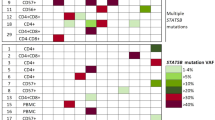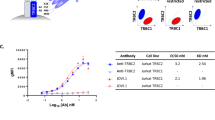Abstract
Cell adhesion molecule 1 (CADM1/TSLC1) was recently identified as a novel cell surface marker for adult T-cell leukemia/lymphoma (ATLL). In this study, we developed various antibodies as diagnostic tools to identify CADM1-positive ATLL leukemia cells. In flow cytometric analysis, the percentages of CD4+CADM1+ double-positive cells correlated well with both the percentages of CD4+CD25+ cells and with abnormal lymphocytes in the peripheral blood of patients with various types of ATLL. Moreover, the degree of CD4+CADM1+ cells over 1% significantly correlated with the copy number of the human T-lymphotropic virus type 1 (HTLV-1) provirus in the peripheral blood of HTLV-1 carriers and ATLL patients. We also identified a soluble form of CADM1 in the peripheral blood of ATLL patients, and the expression levels of this form were correlated with the levels of soluble interleukin 2 receptor alpha. Moreover, lymphomas derived from ATLL were strongly and specifically stained with a CADM1 antibody. Thus, detection of CD4+CADM1+ cells in the peripheral blood, measurement of serum levels of soluble CADM1 and immunohistochemical detection of CADM1 in lymphomas would be a useful set of markers for disease progression in ATLL and may aid in both the early diagnosis and measurement of treatment efficacy for ATLL.
This is a preview of subscription content, access via your institution
Access options
Subscribe to this journal
Receive 12 print issues and online access
$259.00 per year
only $21.58 per issue
Buy this article
- Purchase on Springer Link
- Instant access to full article PDF
Prices may be subject to local taxes which are calculated during checkout





Similar content being viewed by others
References
Yoshida M, Miyoshi I, Hinuma Y . Isolation and characterization of retrovirus from cell lines of human adult T-cell leukemia and its implication in the disease. Proc Natl Acad Sci USA 1982; 79: 2031–2035.
Takatsuki K . Discovery of adult T-cell leukemia. Retrovirology 2005; 2: 16.
Arisawa K, Soda M, Endo S, Kurokawa K, Katamine S, Shimokawa I et al. Evaluation of adult T-cell leukemia/lymphoma incidence and its impact on non-Hodgkin lymphoma incidence in southwestern Japan. Int J Cancer 2000; 85: 319–324.
Proietti FA, Carneiro-Proietti AB, Catalan-Soares BC, Murphy EL . Global epidemiology of HTLV-I infection and associated diseases. Oncogene 2005; 24: 6058–6068.
Karube K, Ohshima K, Tsuchiya T, Yamaguchi T, Kawano R, Suzumiya J et al. Expression of FoxP3, a key molecule in CD4CD25 regulatory T cells, in adult T-cell leukaemia/lymphoma cells. Br J Haematol 2004; 126: 81–84.
Chen S, Ishii N, Ine S, Ikeda S, Fujimura T, Ndhlovu LC et al. Regulatory T cell-like activity of Foxp3+ adult T cell leukemia cells. Int Immunol 2006; 18: 269–277.
Yasuda N, Lai PK, Ip SH, Kung PC, Hinuma Y, Matsuoka M et al. Soluble interleukin 2 receptors in sera of Japanese patients with adult T cell leukemia mark activity of disease. Blood 1988; 71: 1021–1026.
Kamihira S, Atogami S, Sohda H, Momita S, Yamada Y, Tomonaga M . Significance of soluble interleukin-2 receptor levels for evaluation of the progression of adult T-cell leukemia. Cancer 1994; 73: 2753–2758.
Akagi T, Ono H, Shimotohno K . Characterization of T cells immortalized by Tax1 of human T-cell leukemia virus type 1. Blood 1995; 86: 4243–4249.
Furukawa Y, Kubota R, Tara M, Izumo S, Osame M . Existence of escape mutant in HTLV-I tax during the development of adult T-cell leukemia. Blood 2001; 97: 987–993.
Tamiya S, Matsuoka M, Etoh K, Watanabe T, Kamihira S, Yamaguchi K et al. Two types of defective human T-lymphotropic virus type I provirus in adult T-cell leukemia. Blood 1996; 88: 3065–3073.
Koiwa T, Hamano-Usami A, Ishida T, Okayama A, Yamaguchi K, Kamihira S et al. 5′-long terminal repeat-selective CpG methylation of latent human T-cell leukemia virus type 1 provirus in vitro and in vivo. J Virol 2002; 76: 9389–9397.
Takeda S, Maeda M, Morikawa S, Taniguchi Y, Yasunaga J, Nosaka K et al. Genetic and epigenetic inactivation of tax gene in adult T-cell leukemia cells. Int J Cancer 2004; 109: 559–567.
Taniguchi Y, Nosaka K, Yasunaga J, Maeda M, Mueller N, Okayama A et al. Silencing of human T-cell leukemia virus type I gene transcription by epigenetic mechanisms. Retrovirology 2005; 2: 64.
Basbous J, Arpin C, Gaudray G, Piechaczyk M, Devaux C, Mesnard JM . The HBZ factor of human T-cell leukemia virus type I dimerizes with transcription factors JunB and c-Jun and modulates their transcriptional activity. J Biol Chem 2003; 278: 43620–43627.
Satou Y, Yasunaga J, Yoshida M, Matsuoka M . HTLV-I basic leucine zipper factor gene mRNA supports proliferation of adult T cell leukemia cells. Proc Natl Acad Sci USA 2006; 103: 720–725.
Sasaki H, Nishikata I, Shiraga T, Akamatsu E, Fukami T, Hidaka T et al. Overexpression of a cell adhesion molecule, TSLC1, as a possible molecular marker for acute-type adult T-cell leukemia. Blood 2005; 105: 1204–1213.
Murakami Y . Involvement of a cell adhesion molecule, TSLC1/IGSF4, in human oncogenesis. Cancer Sci 2005; 96: 543–552.
Dewan MZ, Takamatsu N, Hidaka T, Hatakeyama K, Nakahata S, Fujisawa J et al. Critical role for TSLC1 expression in the growth and organ infiltration of adult T-cell leukemia cells in vivo. J Virol 2008; 82: 11958–11963.
Tanaka G, Okayama A, Watanabe T, Aizawa S, Stuver S, Mueller N et al. The clonal expansion of human T lymphotropic virus type 1-infected T cells: a comparison between seroconverters and long-term carriers. J Infect Dis 2005; 191: 1140–1147.
Shimizu Y, Takamori A, Utsunomiya A, Kurimura M, Yamano Y, Hishizawa M et al. Impaired Tax-specific T-cell responses with insufficient control of HTLV-1 in a subgroup of individuals at asymptomatic and smoldering stages. Cancer Sci 2009; 100: 481–489.
Kurosawa G, Akahori Y, Morita M, Sumitomo M, Sato N, Muramatsu C et al. Comprehensive screening for antigens overexpressed on carcinomas via isolation of human mAbs that may be therapeutic. Proc Natl Acad Sci USA 2008; 105: 7287–7292.
Koma Y, Ito A, Wakayama T, Watabe K, Okada M, Tsubota N et al. Cloning of a soluble isoform of the SgIGSF adhesion molecule that binds the extracellular domain of the membrane-bound isoform. Oncogene 2004; 23: 5687–5692.
Galibert L, Diemer GS, Liu Z, Johnson RS, Smith JL, Walzer T et al. Nectin-like protein 2 defines a subset of T-cell zone dendritic cells and is a ligand for class-I-restricted T-cell-associated molecule. J Biol Chem 2005; 280: 21955–21964.
Takeuchi A, Itoh Y, Takumi A, Ishihara C, Arase N, Yokosuka T et al. CRTAM confers late-stage activation of CD8+ T cells to regulate retention within lymph node. J Immunol 2009; 183: 4220–4228.
Imai T, Nagira M, Takagi S, Kakizaki M, Nishimura M, Wang J et al. Selective recruitment of CCR4-bearing Th2 cells toward antigen-presenting cells by the CC chemokines thymus and activation-regulated chemokine and macrophage-derived chemokine. Int Immunol 1999; 11: 81–88.
Baatar D, Olkhanud P, Sumitomo K, Taub D, Gress R, Biragyn A . Human peripheral blood T regulatory cells (Tregs), functionally primed CCR4+ Tregs and unprimed CCR4- Tregs, regulate effector T cells using FasL. J Immunol 2007; 178: 4891–4900.
Lim HW, Lee J, Hillsamer P, Kim CH . Human Th17 cells share major trafficking receptors with both polarized effector T cells and FOXP3+ regulatory T cells. J Immunol 2008; 180: 122–129.
Hieshima K, Nagakubo D, Nakayama T, Shirakawa AK, Jin Z, Yoshie O . Tax-inducible production of CC chemokine ligand 22 by human T cell leukemia virus type 1 (HTLV-1)-infected T cells promotes preferential transmission of HTLV-1 to CCR4-expressing CD4+ T cells. J Immunol 2008; 180: 931–939.
Yeh JH, Sidhu SS, Chan AC . Regulation of a late phase of T cell polarity and effector functions by Crtam. Cell 2008; 132: 846–859.
Toulza F, Nosaka K, Takiguchi M, Pagliuca T, Mitsuya H, Tanaka Y et al. FoxP3+ regulatory T cells are distinct from leukemia cells in HTLV-1-associated adult T-cell leukemia. Int J Cancer 2009; 125: 2375–2382.
Yoshie O, Fujisawa R, Nakayama T, Harasawa H, Tago H, Izawa D et al. Frequent expression of CCR4 in adult T-cell leukemia and human T-cell leukemia virus type 1-transformed T cells. Blood 2002; 99: 1505–15011.
Baba M, Okamoto M, Hamasaki T, Horai S, Wang X, Ito Y et al. Highly enhanced expression of CD70 on human T-lymphotropic virus type 1-carrying T-cell lines and adult T-cell leukemia cells. J Virol 2008; 82: 3843–3852.
Acknowledgements
This work was supported by Grants-in-Aid for Scientific Research of Priority Area and for twenty-first Century COE program (Life science) from the Ministry of Education, Culture, Sports, Science and Technology, Japan Leukemia Research fund, and Research fund from Miyazaki Prefecture Collaboration of Regional Entities for the Advancement of Technological Excellence, JST.
Author information
Authors and Affiliations
Corresponding author
Ethics declarations
Competing interests
The authors declare no conflict of interest.
Additional information
Supplementary Information accompanies the paper on the Leukemia website
Supplementary information
Rights and permissions
About this article
Cite this article
Nakahata, S., Saito, Y., Marutsuka, K. et al. Clinical significance of CADM1/TSLC1/IgSF4 expression in adult T-cell leukemia/lymphoma. Leukemia 26, 1238–1246 (2012). https://doi.org/10.1038/leu.2011.379
Received:
Revised:
Accepted:
Published:
Issue Date:
DOI: https://doi.org/10.1038/leu.2011.379
Keywords
This article is cited by
-
Acute type adult T-cell leukemia cells proliferate in the lymph nodes rather than in peripheral blood
Cancer Gene Therapy (2022)
-
Quantification of T cell clonality in human T cell leukaemia virus type-1 carriers can detect the development of adult T cell leukaemia early
Blood Cancer Journal (2021)
-
Novel targeted therapies of T cell lymphomas
Journal of Hematology & Oncology (2020)
-
Development of anti-human CADM1 monoclonal antibodies as a potential therapy for adult T-cell leukemia/lymphoma
International Journal of Hematology (2020)
-
Expression of TSLC1 in patients with HAM/TSP
Journal of NeuroVirology (2020)



